Skateboarding Meets Painting: A Cultural Journey
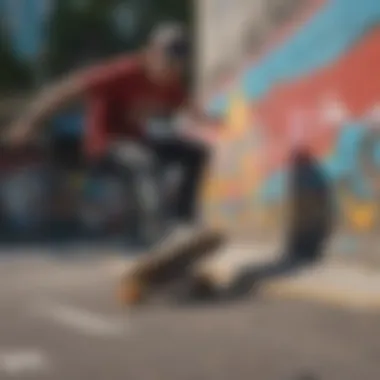
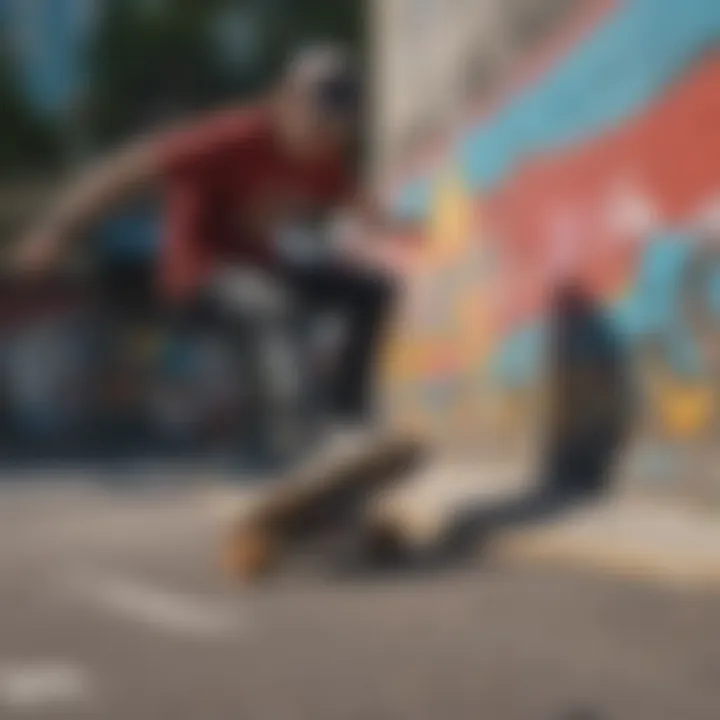
Intro
The intricate relationship between skateboarding and painting is far more nuanced than it might initially seem. Both art forms celebrate freedom, rebellion, and individual expression. This guide delves into their interwoven narratives within contemporary culture, revealing how each entity enriches the other. As skateboarding evolves so does its connection to art, cultivating vibrant communities where creativity flourishes.
Techniques and Tips
In exploring the intersection of these two forms, there exists a significant need for understanding certain techniques that artists can adopt from skateboarding and vice versa. Whether through personalized skateboards or incorporating skate culture into artwork, skill development is vital.
Skill Development
Artists wishing to integrate skateboarding into their work should immerse themselves in the culture. Observing skaters, understanding the language of tricks, and appreciating the visceral experience of skate parks can only deepen their artistic expression. Understanding the physics behind skating can also help artists depict movement more accurately in their art.
Practical Techniques
- Use of Color and Texture: Inspired by the vibrant graffiti often found in skate parks, artists can experiment with bold colors and different textures. Skateboard decks also present a unique surface that can influence painting styles.
- Incorporating Symbols: Icons from skate culture such as brands like Element or Baker can be infused into artwork as a form of communication.
- Interactive Art: Create street art that is meant to be interacted with by skaters, thereby merging the two disciplines dynamically.
Common Mistakes to Avoid
- Ignoring Context: Artwork needs to resonate with the skate culture context. Skating is identity-based, and art should reflect that.
- Overcomplication: Sometimes simplicity speaks louder than complexity. Avoid overloading visuals with too many details.
- Neglecting the Process: Both skateboarding and painting are about the journey. Focusing too much on the end product can stifle creativity.
Gear and Equipment
Artistic exploration of skateboarding requires specific gear tailored for both skate and paint applications. Understanding what gear is ideal can augment the experience and outcome of artistic endeavors.
Essential Gear for Beginners
- Skateboard: A durable skateboard suited for your style is essential.
- Art Supplies: A selection of quality paints, brushes, and spray cans aligned with skills level.
- Protective Gear: Helmets and pads not only protect while skating but can inspire unique artistic designs.
Latest Innovations and Trends
New materials and technology influence both skateboarding and painting. Skateboards can now feature customizable art directly on the deck and materials enable artists to create works unique to skate culture.
“The synergy between skating and art does not just create aesthetics; it also fosters community and identity.”
Safety Measures
Partaking in either skateboarding or painting in high-energy environments necessitates safety awareness. Prioritizing health can maintain the creative flow in both practice areas.
Essential Safety Gear
- Helmets: A non-negotiable for skaters
- Knee and Elbow Pads: These can save skin and bone from impact.
- Wrist Guards: Prevent injuries while painting, particularly if using pressure.
Best Practices for Safe Participation
- Warm Up: Always prepare your body before any physical activity with light stretching.
- Know Your Environment: Whether skating or painting outdoors, be aware of surroundings to avoid accidents.
- Practice Skills Gradually: Once familiarity is built, gradually work on more challenging tricks or intricate artwork.
Injury Prevention and Management
Recognizing injuries early can prevent long-term issues. Having a solid first aid kit during activities, especially at larger events, is essential.
Spotlights on Extreme Sports
To fully encapsulate the energy surrounding skateboarding and painting, it's beneficial to showcase extreme sports through stories and profiles.
Featured Sport of the Month
This section can focus on highlighting one sport monthly, illustrating its tie to art and creativity within its community.
Profiles of Prominent Athletes
Featuring artists who are also skaters, such as Ed Templeton, provides insight into how these realms intersect. Their journeys can inspire budding artists and skaters alike to explore the connection between these two vital forms of self-expression.
Understanding Skateboarding
Skateboarding represents much more than just a recreational activity. It embodies a rich history, a distinct culture, and a unique form of expression that influences various aspects of modern life. It captures the essence of individuality and creativity, making it an important subject of exploration within the context of this article. In understanding skateboarding, one gains insights into how it has shaped artistic endeavors and fostered vibrant communities.
History of Skateboarding
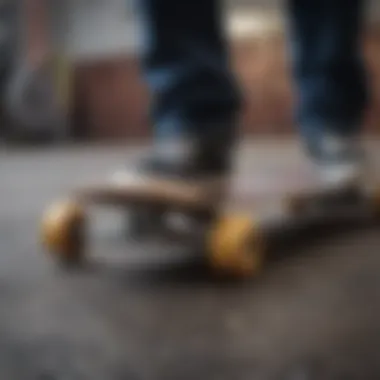
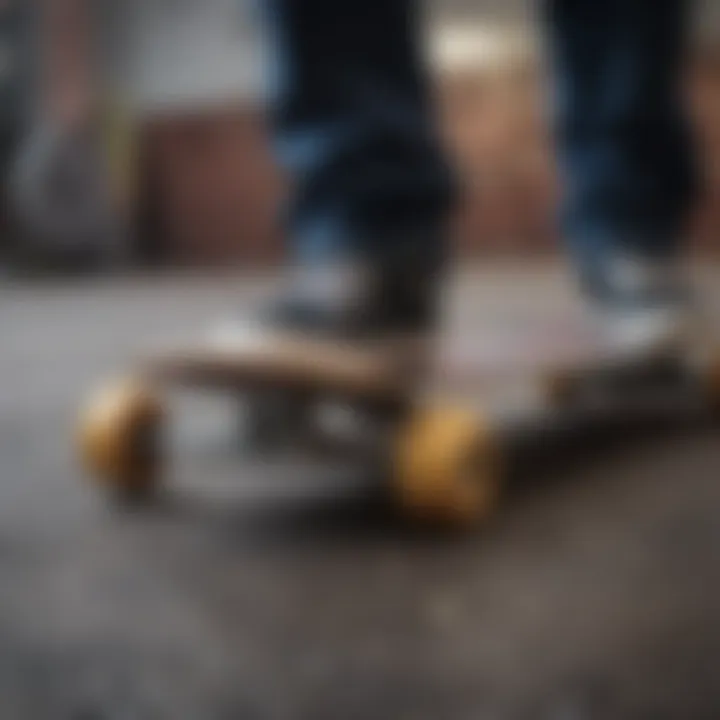
The roots of skateboarding can be traced back to the 1940s and 1950s in California. Surfers were looking for a way to practice their skills on land when they began attaching roller skate wheels to wooden planks. This innovation led to the emergence of a new sport that evolved over time. By the 1970s, skateboarding gained significant popularity, characterized by pioneering street styles and tricks.
As skateboarding progressed, so did the design of the boards themselves. The introduction of wider decks and improved grip tape allowed for greater maneuverability, fostering the development of various tricks and styles. The advent of vertical ramps in the 1980s further revolutionized the sport, marking a golden age for skateboarding.
Cultural Significance
Skateboarding holds substantial cultural significance, impacting not only sports but also music, fashion, and art. Its subculture is often linked to rebellion and individuality, attracting people who strive for personal expression. Through skateboarding, participants create a sense of belonging and community.
Many iconic skateboard brands like Thrasher and Santa Cruz have shaped the aesthetics of the scene. These brands often incorporate artistic elements on their products, reflecting the DIY ethos that is prevalent in skate culture.
In essence, understanding skateboarding requires an appreciation of its rich history and cultural ramifications. It highlights the relationships between sports, art, and identity, ultimately showing how these elements intertwine to form a dynamic and influential movement.
Artistic Expression Through Skateboarding
Artistic expression is central to the fusion of skateboarding and painting. It is not merely about the sport itself, but how skateboarding becomes a medium for individual identity and creativity. The aesthetic element is often intertwined with the physicality of the sport. For many skaters, the act of riding the board becomes a canvas to articulate their thoughts and feelings about their environment.
In this section, we will analyze the various aspects of artistic expression that skateboarding entails, examining the intimate relation between design, identity, and community.
The Role of Design in Skateboarding
Design plays a crucial role in the skateboarding world. It encompasses everything from the skateboard decks to clothing and accessories. Deck designs can reflect personal interests, social statements, or artistic styles. As such, the visual elements become an extension of the skater's identity. The increasingly popular trend of customizing boards allows skaters to showcase unique styles, portraying their views and personalities.
There are several factors to consider regarding design in skateboarding:
- Cultural Reflection: Designs sometimes capture and comment on current societal issues, making the art relevant and poignant.
- Innovation: Advances in technology allow for new techniques and styles in skateboard art and design.
- Collaboration: Artists, designers, and skaters often collaborate to create limited edition decks, bridging two worlds into a single creation.
Ultimately, design in skateboarding serves not only as an aesthetic choice but can symbolize resistance, empowerment, or innovation, reflecting deeper cultural narratives.
Skateboards as Canvases
Skateboards are more than just equipment for performing tricks. They can be seen as dynamic canvases for artistic expression that transcends traditional boundaries. Artists have embraced this idea, using the decks not only as a medium but also as a platform to display their work in a non-traditional setting. The skateboard itself allows for a more diverse exploration of themes and styles within the realm of art.
Some key considerations include:
- Materiality: Skateboards are made from wood or materials that may influence the type of paint or art techniques used.
- Accessibility: Unlike galleries, skateboards are often in public spaces, allowing a wider audience to appreciate the art.
- Movement: The act of skating gives life to the art. Each board is not static, making it interesting as it moves through streets, parks, or skate bowls.
"Art is not what you see, but what you make others see." - Edgar Degas
This intersection of skateboarding and painting continues to foster vibrant discussions about cultural expression. It holds the potential to inspire future generations to engage with both mediums, shaping the identity of the skateboarding culture.
Skate Art: Origins and Evolution
The relationship between skateboarding and painting has developed uniquely, creating a distinct cultural phenomenon known as skate art. This section delves into the origins and evolution of skate art, elucidating how it emerged as a significant form of expression within the skateboarding community. Understanding skate art is crucial to comprehending its role in shaping identity, fostering creativity, and bridging various artistic movements. The very essence of skate art reflects the rebellious spirit of skateboarding while simultaneously capturing individual stories and community narratives, thus allowing artists and skaters to encapsulate their shared experiences through visually striking imagery.
Early Examples of Skateboard Art
Early examples of skateboard art can be traced back to the 1970s when skateboards began to transform from simple wood planks into canvases for artistic expression. Pioneering skateboard companies, like Dogtown and Powell Peralta, played pivotal roles in this evolution. Skateboard decks not only served their original purpose but also became platforms for artists to showcase their creativity. Graphics often featured bold colors and dynamic illustrations, drawing inspiration from punk music, surf culture, and street art. The emergence of these designs allowed skaters to personalize their boards, creating a strong sense of individuality within the community. As artists began to explore the aesthetics of skateboarding, they contributed to a vibrant culture that celebrated action, energy, and defiance.
Influential Artists in Skateboarding
Several influential artists have left an indelible mark on skate art over the years. Notable figures such as Jim Phillips, who created iconic designs for Santa Cruz Skateboards, shaped the way skate culture is perceived and celebrated. His work, characterized by exaggerated lines and whimsical characters, became synonymous with the skateboarding aesthetic of the 1980s. Moreover, contemporary artists like Shepard Fairey have intertwined street art with skate culture, using skateboards as canvases to comment on social issues and challenge mainstream narratives.
“Art is not what you see, but what you make others see.” - Edgar Degas
The collaboration between skaters and artists continues to evolve, pushing the boundaries of creativity. This intersection not only amplifies the appeal of skateboarding but also invites a broader audience to engage with its culture. Overall, understanding the origins and evolution of skate art reveals its significance as a powerful language of self-expression and identity within the skateboarding world.
The Fusion of Skateboarding and Painting
The fusion of skateboarding and painting is a complex interplay that extends beyond mere aesthetics. This relationship is often rooted in a shared appreciation for creativity, individuality, and community. Both skateboarding and painting allow for personal expression and have become intertwined in ways that reflect cultural attitudes, social movements, and individual identities. The significance of this fusion is highlighted by the evolution of skate art, which serves as a potent form of visual communication and lifestyle representation.
One of the major benefits of this fusion is the platform it creates for artists. Skateboards are not just needs for transportation or tricks; they are canvases that artists can customize and personalize. Skaters often express their artistic inclinations through their boards, showcasing unique designs that reflect their identities or beliefs. This creates a culture of personalization, allowing for an array of artistic expressions on the same medium, fostering a sense of community among skaters and artists alike.
Furthermore, the intersection of these two forms of art promotes collaboration. Artists and skaters often come together for various projects, blending their skills and visions in innovative ways. This collaboration is paramount in contemporary culture, where authenticity is valued. It produces a dialogue that enriches both communities, encouraging a more inclusive environment for creativity.
The fusion is also important for nurturing emerging trends within the art world. Skate art has gained recognition in mainstream galleries and exhibitions. This acceptance paves the way for new artistic movements and styles, influenced by the skateboarding lifestyle. It opens avenues for underrepresented voices and styles to emerge, pushing the boundaries of traditional art.
In summary, the fusion of skateboarding and painting is not merely a combination of two interests; it represents a cultural evolution that encourages self-expression, community, and innovation. As we delve deeper into this topic, it becomes evident how impactful this intersection has been on both artists and skaters.
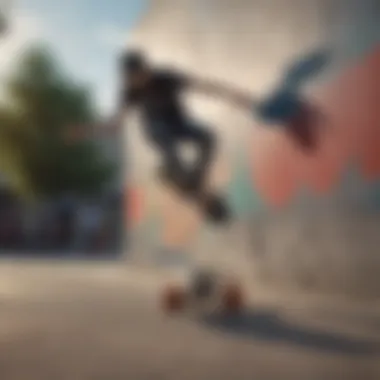
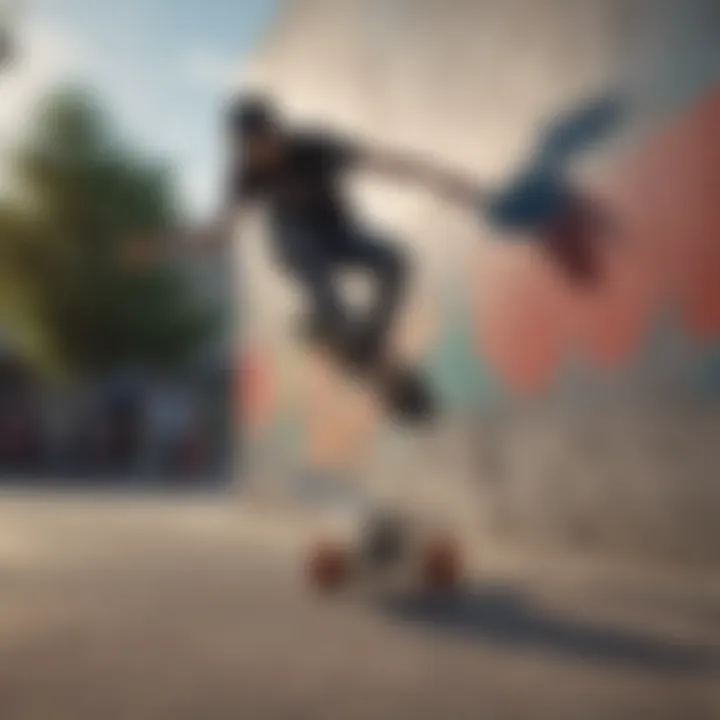
Contemporary Skate Art Movements
Contemporary skate art movements are diverse and reflect the multitude of voices within the skate community. Artists today are not only skate enthusiasts but also individuals who challenge traditional forms of art. This emergence has led to various movements that have shaped how skate art is perceived and celebrated.
One notable movement is the use of graffiti styles in skate art. These bold and often vibrant designs now dominate the board culture. Artists such as Shepard Fairey and KAWS have successfully blurred the lines between street art and skateboarding, creating works that appeal to both realms. Their influence can be seen in the popularization of designs that evoke both energy and individuality, creating a vibrant expression of artistry.
Another movement is the rise of digital art, where technology meets traditional artistry. Many skaters now use digital platforms to create and share their designs, which can then be printed on skateboards. This accessibility allows a wider range of artists to participate in the culture.
Moreover, themes of social justice and activism increasingly find their way into skate art. Many artists address issues such as inequality, mental health, and environmental concerns through their designs, using their boards as a medium for a voice. This aligns with the ethos of skateboarding as an alternative culture that often challenges societal norms.
Ultimately, contemporary skate art movements are powerful indicators of the evolution of skate culture itself. The dialogue between these movements and the broader art world continues, with new trends and collaborations emerging all the time.
Exhibitions and Events
Exhibitions and events celebrating the intersection of skateboarding and painting play an important role in promoting this cultural dialogue. They offer a space where artists, skaters, and enthusiasts can come together to explore new works, share ideas, and celebrate individuality.
One prominent event is the annual "Skate Art Show," which brings together local artists and skaters for a week-long event filled with workshops, demonstrations, and exhibitions. This event not only showcases skate art but also opens discussions around the cultural implications of merging these forms. Participants often leave with a deeper understanding of how their passion for skateboarding can intertwine with artistic expression.
Additionally, galleries such as the "Venice Beach Skate and Art House" serve as hubs for promoting skateboard art. They host regular exhibitions that highlight emerging artists while also serving as community spaces for skaters to gather. This not only elevates skate art into established art circles but also fosters an inclusive community spirit.
Moreover, collaborations for skate films often draw attention to the artistry involved in skating. These productions highlight not just the physical aspects of skateboarding but also the aesthetic components that make it visually compelling. An example is "The Art of Flight," which showcases both the skills of the athletes and the cinematography, effectively blending the two worlds.
Identity and Self-Expression in the Skate Community
The skate community is a vivid tapestry of different identities and expressions. Individuality plays a vital role in how skaters connect with each other and the culture as a whole. This identity means more than just a label; it reflects a lifestyle that encompasses values like freedom, creativity, and authenticity. The skate community allows individuals to form a unique self-concept, where personal style and artistic expression meet on the very board they ride.
Personalized Skateboards and Individuality
Personalized skateboards serve as crucial tools for self-exploration. These boards, often adorned with custom graphics or colors, showcase personal tastes and beliefs. For many, the act of designing a skateboard transforms it into a canvas that communicates their identity to the world. This customization can include the use of specific color schemes, images, and even words that resonate with the skater’s personal story.
Moreover, this focus on individuality extends beyond visuals. The shapes and sizes of skateboards can reflect a skater’s style and preferences in maneuvering. As some choose wider boards for stability, others prefer narrower ones for trick execution. This choice signifies deeper implications about one's identity within the skate culture.
Art as a Reflection of Skate Culture
Art is a mirror that reflects the skate community's diverse values and experiences. The graphics used in skateboarding often tell stories about the community's struggles, triumphs, and aspirations. Many artists draw inspiration from street art, which is itself a form of self-expression born from similar cultural contexts. These visual narratives go beyond mere aesthetics; they evoke emotions and provoke thought.
Skate art often addresses social issues, challenges norms, and encourages dialogue within the community. For instance, some designs may incorporate themes of rebellion or defiance, resonating with the counterculture aspect of skateboarding. Others reflect camaraderie or shared experiences, reinforcing the bonds within the skate community.
"Skateboarding is not just a sport. It's a medium for self-expression and art. It allows us to show the world who we are."
As a result, art becomes a dynamic element of skateboarding culture. It not only enhances the visual appeal of the skateboards but also contributes to the overall identity of skaters as individuals and as a collective. This mutual influence creates a powerful environment where personal expression and cultural identity are continuously evolving.
Skateboarding as a Source of Inspiration for Artists
Skateboarding has emerged as a significant source of inspiration within the realm of modern art. This influence stems from various facets of skate culture, including its aesthetics, community spirit, and underlying philosophies. Artists draw from the vibrant street life and raw energy that skateboarding embodies. The movement of skaters, their tricks, and the urban landscapes they navigate offer a wealth of creative material for artistic exploration.
The relationship between skateboarding and art is collaborative. Many artists actively participate in the skating community. They experience firsthand the thrill and challenges that skaters face. This shared experience bridges the gap between the two worlds, allowing for a rich dialogue to take place. Artistic representations of skateboarding often reflect the freedom and rebellion associated with the sport.
The benefits of this artistic inspiration are manifold. Artists who engage with skate culture often find their work resonates more deeply with audiences who share that passion. Skateboarding's dynamic nature encourages spontaneity, which can lead to innovative artistic expressions. Additionally, the aesthetics of skateboarding—colors, graphics, and graffiti—offer a visual language that many artists adopt in their creations.
In considering skateboarding as a source of inspiration, it is important to recognize how it invites artists to challenge norms and embrace creativity. The culture of skateboarding is rooted in self-expression and individuality. Thus, artists can find unique ways to interpret their experiences on a skateboard through various mediums, such as painting, sculpture, and photography.
The Impact of Skateboarding on Modern Art
Skateboarding has influenced modern art in numerous ways. From the use of skateboards as canvases to the integration of skate culture in artistic themes, the effects are evident. Notable movements such as street art have evolved partly due to the visibility and accessibility of skateboarding. The imagery associated with skateboarding often appears in galleries and exhibitions, bridging the gap between the streets and formal art spaces.
The incorporation of skateboarding elements in modern art serves various purposes. It often critiques societal norms and reflects issues relevant to youth culture. Moreover, the skateboard itself has become a symbol of freedom and rebellion. Artists leverage this symbolism to confront broader conversations in their work.
Artists Who Skate: A Dual Identity
Many artists who engage with skateboarding embody a dual identity. They are not only creators but also practitioners of the sport. This duality enriches their art, as they translate their experiences and the culture directly into their work. The interplay between skating and artistic creation allows for deeper emotional and physical connections to emerge.
This identity often shapes how artists perceive their work, integrating aspects of skate culture. For example, some artists use their personalized skateboards as a canvas, painting designs that represent their individuality. Others may document their skating experiences through photography and video, capturing the essence of urban exploration.
In summary, the intersection of skateboarding and painting is marked by continuous inspiration. This relationship fosters creativity and commences dialogues between different art forms, reflecting the unique culture surrounding skateboarding. Artists remain deeply influenced by skating, finding in it not just a source of content, but an intrinsic part of their identity.
Community and Collaboration in Skate Art
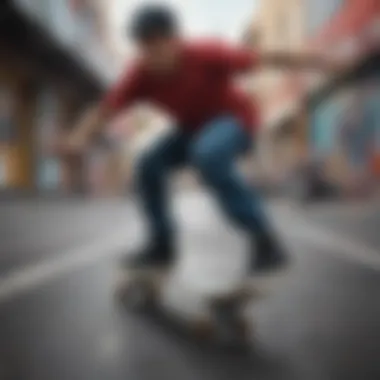

The relationship between skateboarding and painting thrives on community and collaboration. Skate art has evolved not just as an individual pursuit but as a movement that brings together various stakeholders. This synergy enhances the cultural landscape of skateboarding, fostering a sense of belonging and shared identity among artists and skaters alike. Collaborative endeavours enrich the skate art scene by combining diverse perspectives and talents.
In many ways, community collaboration creates opportunities for skaters to express themselves beyond the physical act of skating. It provides a platform for artists to engage with skate culture, reflecting the collective ethos in their creations. These projects often lead to enriching experiences that reinforce social bonds and promote artistic innovation.
Collaboration between skaters and artists promotes awareness of the artistic potential within the sport. It emphasizes how skateboarding can be both a hobby and a canvas, thus transforming any standard piece of wood into something deeply personal and meaningful. Artists use this opportunity to experiment and evolve their styles, influenced by the skaters’ experiences and backgrounds.
Moreover, this community engagement stimulates grassroots movements, where local talent showcases their work. It strengthens the connections between individuals, leading to a more vibrant artistic ecosystem. Events often highlight these collaborations, where the boundaries of sport and art blur, resulting in dynamic creations that resonate with audiences.
"Through collaboration, skate art has become a reflection of the community. It's a shared voice that embodies both struggle and triumph."
Collaborative Projects Between Skaters and Artists
Collaborative projects stand out in the skate art community. Skaters and artists team up, merging their skills to create something that transcends typical boundaries. These projects may take many forms, such as murals, skatepark designs, or limited-edition skateboard decks.
Such initiatives make art accessible and relatable. When local artists partner with skaters, the results can capture the essence of specific communities. For example, a mural painted in a local skatepark can symbolize the spirit and struggles of the local scene, making it an integral part of the environment.
Some notable projects include:
- Skateboard Deck Art Installations: Creators use blank decks to make unique art pieces that tell stories about skater lifestyles.
- Community Mural Projects: Artists often collaborate with skaters to beautify their local areas, creating impactful visual narratives within their neighborhoods.
- Art Competitions: Some events encourage skaters to submit their art on skateboards, highlighting both artistic talent and unique skating styles.
These projects often draw attention to local issues and reflect various cultural aspects, all while building connections among community members.
The Role of Skate Shops in Promoting Art
Skate shops are pivotal in promoting skate art. They serve as cultural hubs where skaters and artists can connect. Many skate shops not only sell equipment but also showcase local art through their spaces. By providing a platform for emerging artists, they encourage creativity within the skate community.
Skate shops play key roles in:
- Hosting Art Exhibitions: Many shops host regular exhibitions, inviting artists to display their work, thus expanding their reach and creating visibility for new talent.
- Collaborating on Limited Edition Products: They work with artists to design exclusive skateboards and merchandise, often leading to unique, collectible items that reflect local culture.
- Community Events: Skate shops organize events that promote interaction between skaters and artists, strengthening community ties.
These efforts not only facilitate artistic creation but also help normalize the presence of art within the skate culture. By supporting local art and artists, skate shops become essential to the ongoing dialogue between skateboarding and painting.
The Future of Skateboarding and Painting
The future of skateboarding and painting is a critical topic that merges two forms of expression in a rapidly evolving cultural landscape. As skate culture continues to gain prominence, it influences how art is created, appreciated, and consumed. The intertwining of these art forms fosters an environment rich with potential for creativity, collaboration, and innovation. Understanding this future can benefit both artists and skaters, as they navigate the unique challenges and opportunities presented by new tools, platforms, and philosophies.
Emerging Trends and Technologies
In recent years, the integration of technology in both skateboarding and painting has started to reshape how these two communities interact. From digital art platforms to social media marketing, the accessibility of tools has lowered the barriers for aspiring artists and skaters.
For example, skate videos are increasingly becoming art forms themselves, showcasing aesthetic angles and artistic techniques that capture the thrill of skateboarding. Moreover, augmented reality (AR) and virtual reality (VR) are being used to create immersive experiences that blend skateboarding and painting into new forms of artistic expression. With technologies like 3D printing, artists can go beyond traditional materials, producing skateboards that are not only functional but also works of art.
Sustainability in Skateboard Art
As awareness of environmental issues grows, sustainability has become a significant consideration in skate art. More artists are seeking eco-friendly materials and processes in their work. This shift aligns with a broader movement toward responsible production and consumption across the creative industries.
Utilizing reclaimed wood or recycled plastic skateboard decks, for instance, reflects a commitment to sustainability while offering unique aesthetics. Brands are beginning to emphasize green practices, encouraging skaters to think about the environmental impact of their boards.
By integrating sustainability into their practices, artists can not only contribute positively to the environment but also appeal to a growing audience that values conscious consumption.
"The new wave of skate art is not just about looks; it's a statement on culture and responsibility."
Overall, the future of skateboarding and painting is bright, supported by innovations and a commitment to sustainability. As we move forward, dialogues between skaters and artists will continue to shape the narratives within these communities, deepening their connection and expanding the horizons of artistic expression.
Epilogue: The Ongoing Dialogue between Skateboarding and Art
The relationship between skateboarding and art is vibrant and dynamic. Both forms serve as mechanisms for self-expression, reflecting individuality and culture. This conclusion segment highlights the continuous interplay between these realms, emphasizing that skateboarding is not merely a sport or recreational activity; it has evolved into a powerful avenue for artistic expression.
The dialogue between skateboarding and art influences various aspects of modern life. Artists draw inspiration from the aesthetics of skate culture, while skaters adopt artistic elements into their routines. The mutual respect and synergy enhance both communities, bridging gaps and fostering collaboration.
Most importantly, this dialogue fuels creativity. Skateboarding provides a unique environment where art can be experienced in motion, enabling instantaneous interactions. Art on skateboards adds a personal flair, showcasing individuality while promoting diverse styles and techniques. This intersection opens pathways for artists to converse with an audience that shares their passion for skating.
"Skateboards are a way to communicate ideas and emotions, transcending mere sport to form a cultural dialogue."
Reflections on the Cultural Impact
The cultural impact of this convergence cannot be overstated. The skateboarding community often mirrors societal views, embracing change and evolution. Artistic expression through skateboarding provides a platform for conversations about identity, politics, and social issues.
Consider the influence of distinct skateboard designs. Iconic patterns and imagery can reflect cultural movements or highlight pressing concerns of the time. Artists often use skateboards as canvases to challenge norms and evoke emotional responses.
Moreover, the presence of skate art in urban settings transforms public spaces. Murals, installations, and skateboard parks become vibrant expressions of local culture, encouraging community engagement. Emerging artists find valuable exposure in these platforms, enabling them to connect with both local and global audiences.
Encouraging New Generations of Artists and Skaters
As the growth of skate art continues, it is crucial to encourage new generations of creators. Educational programs and workshops focusing on skateboard design and art integrate creativity into youth culture. Engaging young skaters can help them appreciate this art form and express themselves authentically.
Skate parks and community events promoting art competitions and exhibitions create vibrant ecosystems. These spaces invite collaboration between young skaters and seasoned artists, fostering mentorships. As they come together to share skills and knowledge, they contribute to a more enriched culture.
In summation, the ongoing dialogue between skateboarding and art not only impacts existing communities but also kindles new flames of creativity and expression. By embracing this cultural intersection, we pave the way for a future where skateboards remain not just tools for sport, but canvases for artistry and reflection.







